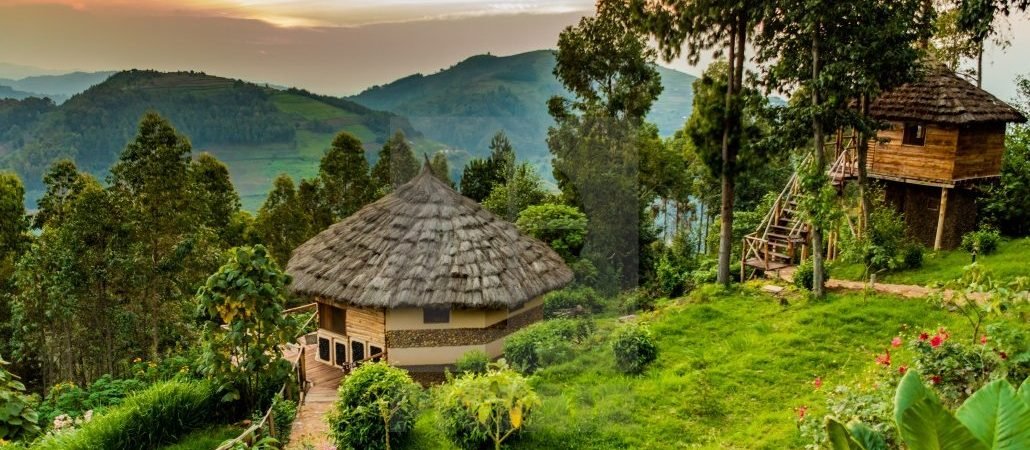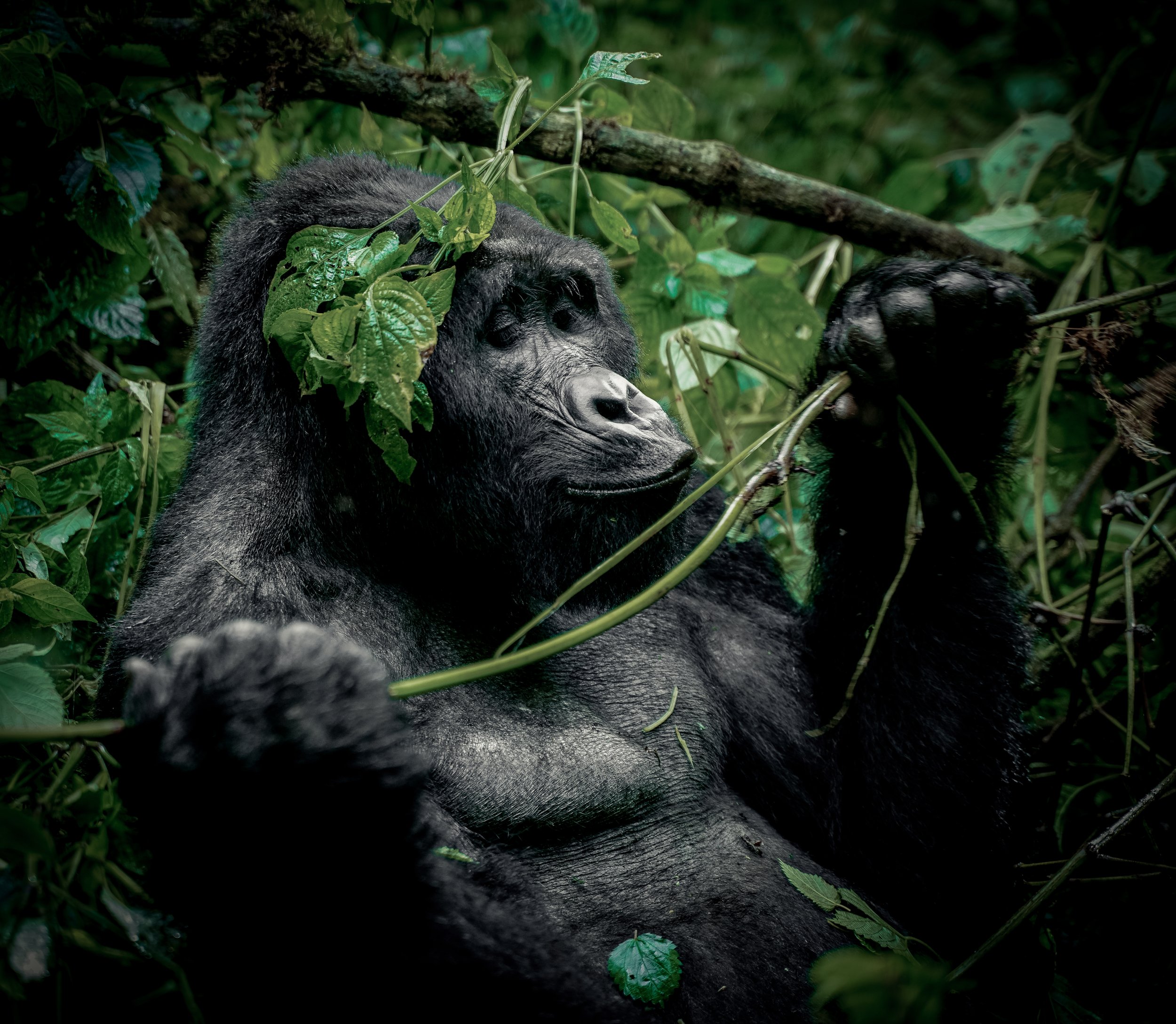Gorilla Trekking at Bwindi Impenetrable Forest
Should you do it?
Gorilla Trekking in Uganda is a once in a lifetime opportunity with these critically endangered animals and something that you just cannot miss.
We very nearly passed on the opportunity, having already booked the Chimpanzee Trek, but we soon found that it was one of the best things we would ever do!
Is It Safe?
You won’t find any guerillas in the jungle, just gorillas. Gorilla Trekking in Uganda is perfectly safe in terms of human interventions. What is a very small possibility is an encounter with forest elephants or leopards. Even if this unlikely event occurs, these animals will most likely flee. However, for additional security, that’s why there are rangers with you, carrying rifles with blanks to fire in the air to scare off any aggression.
In terms of the gorilla troops, it has taken the Ugandan Wildlife Authority years to build up a trust with the mountain gorillas of Bwindi. If you respect the rules laid out by the rangers, there is only one outcome: a wonderful, safe experience with the gorillas.
How To Do It: Getting There
By Road: Bwindi forest is most easily accessed from Queen Elizabeth National Park to the North (2-3 hours drive) or from Kampala through Mbarara (6 to 8 hours drive)
By Air: You can choose to fly from Entebbe or from Kampala (at Kajansi airfield) to the airstrip at Kisoro. Check out flight information through Aerolink.
How To Do It: Permits
The Uganda Wildlife Authority release a very limited amount of permits to trek at Bwindi each day, which are mandatory to trek with the gorillas. This is to regulate the interactions these wild gorillas have with humans each day. There are only 8 available permits per gorilla group each day, so they book up, far in advance.
The cost is:
700 USD for a foreign visitor
600 USD for a foreign resident
Book with a tour company in Uganda, and they’ll handle the booking for you.
How To Do It: Entrances
There are four entrances to Bwindi Impenetrable National Park, because of the vastness of the park:
– Buhoma in the North
– Ruhija in the East
– Rushaga in the South
– Nkuringo in the South
They are open all year round, so check out which entrance is closest to your stay.
Where To Stay
There are many great places to stay around Bwindi, but, for us, our favourite has to be Agandi Uganda Eco-Lodges in Ruhija.
Agandi Uganda Ltd is a social eco-tourism company founded by people who share the same passion for the Pearl of Africa and the same vision for an inclusive eco-tourism in Uganda.
Travelling to natural wonders, all over the World, we are incredibly conscious of the social and environmental impact of our travels. This lodge combines affordable luxury, with a positive impact on the local communities in Ruhija, and the environment.




What To Do: Packing
This part is incredibly important. You could be trekking for hours in thick forest so ensure you pack all of the essentials below:
A waterproof jacket
Long trousers (pants), preferably waterproof
Hiking shoes (we highly recommend this as entrance into the forest can be wet and very steep)
Thick walking socks
Sunscreen (you are mostly shaded but always handy to have in the bag)
Lots of water
A good camera, charged and ready to snap all of those great photos!
On The Day
For us, the day started nice and early, ready for a morning trek into the forest. We’d recommend being well rested, as the trek can vary considerably in length, based on how far you have to travel to find one of the gorilla groups.
We made our way to the entrance at Ruhija, for a safety briefing with the local rangers from the Ugandan Wildlife Authority, hearing all about the forest, gorillas and the conservation efforts in the area.
This was the last place to stop for the bathroom, so we would recommend going, even if you don’t need to.
How do you know where to go in a park that is 130 square miles? Expert trackers are sent out to monitor the movements and whereabouts of different gorilla groups. This is not only a benefit for us, but it also helps with the conservation efforts: monitoring numbers, group dynamics, and the general health and safety of each group.
So we were informed of a group that was about a 2hr trek from where we started, and this would be the group we were heading to.
Porters
Local members of the community walk, on foot, for a few hours from their villages, to be optional porters, supporting you with the forest trek. We were unsure of the need or want of using a person to support us, but there were people who had travelled 3hrs+ just to get the chance of some work, so we paid an additional $10 to have a porter, support us. This, in fact, proved invaluable because the decline into the forest was unbelievable. They made the trek down into the jungle much more manageable for us!
Nothing can quite prepare you for a face-to-face encounter with a wild gorilla. Having travelled all over the world, getting up close to many wild animals, there is something unique and incredibly special about looking into the eyes of an animal so alike, yet so different to us.
In Bwindi, once we reached the area where our gorilla troop was, we quite literally stumbled straight into them: turning around to be faced with a huge silverback, no more than 2 meters away.
A permit gives you 1hr to spend time with the troop, but a lifetime wouldn’t be enough to experience the sheer reality of experience that this encounter brings you.
Wild, scary creatures…? This couldn’t be further from the reality of these gentle giants, that share 98.3% of their genetic code with humans. Our troop had two large silverback males and two newborn babies. Watching the intelligence, tenderness and love shown throughout the group, in the upbringing and nurture of these two newborns can’t be put into words.
We followed the troop’s movements, through the forest, as they gracefully moved about eating, climbing and playing. At one stage, the dominant silverback approached us to just size us up, in their environment, but we were trained on what to do in this situation. We remained still and the rangers made a call, representing a friendly submission, and the silverback calmly moved passed us, brushing us as he went.
You are told that you have to keep a certain distance from the troop yourself, but if any of them approach you, that is their prerogative and you just stand still, allow it to happen…and enjoy it!
It is safe to say that we could have spent days, following this troop’s activities but, when it was time to leave, we left the group with a heavy heart and unbelievable admiration. We could write pages about our interaction with them but you can only understand this when you experience it for yourself: unique, magical!
The Gorillas





















